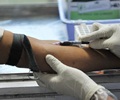The C4 strain is found only in the northern territory region of Australia which has high rates of liver cancer among Indigenous Australians.

Dr Josh Davis said the strain seemed to be more aggressive than the strains found elsewhere. This particular C4 virus is quite ancient and probably entered Australia around 53,000 years ago. That also happens to be when we also think that people entered Australia based on the fossil records.
"So this virus has probably co-evolved with anatomically modern humans since leaving Africa and this particular strain has branched off just before Indigenous people came to Australia. Like all organisms, HBV can be divided into subtypes, and in all other regions of the world there are several subtypes of HBV within the population. However in the NT, there is only one subtype of HBV, and this has only ever been found in northern Australian Indigenous people," he added.
The researchers have uncovered the rare strain while undertaking genetic fingerprinting research among Hepatitis B affected inhabitants.
There was a previously rare or rarely described subtype of hepatitis B that we found in every single person we have tested. That means researchers can now focus on diagnosing the disease early so it can be effectively treated to prevent cancers developing, said Dr Davis.
Advertisement















